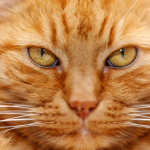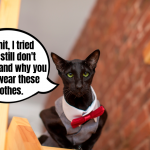Cats are truly colorful creatures among which it’s hard to find two identical individuals. From the tiniest markings on their fur, through unique colour mixes to different eye colors – each detail is reflected in the cat’s genes and lets them stay true to their individualistic nature in the most rainbow-like dimension. What we see with the naked eye is not all – cat colors are hiding many secrets and tidbits that may surprise many cat Guardians. Is it true that white cats with blue eyes are at a high risk of being deaf or that calico cats are always female and never male? Sit comfortably, fabCats, get your cats on your lap and find out what is the magic behind cat colors.
The mystery behind blue eyes
Let’s start with a tidbit that some cat Carers might have just barely heard of. Cats with white fur and blue eyes have a much higher risk of being deaf than cats with other colors. Why? According to studies, about 10-20% of white cats are born with hearing problems. If they additionally have one blue eye (they can have heterochromia), the risk goes up to 30-40% and with two blue eyes, even to 60-80%. It’s difficult to pinpoint the exact cause of that, but researchers say that it has a lot to do with the specific traits of genes responsible for white fur.
It is certain that if a white cat has at least one blue eye, the risk of them being deaf on one ear (the same side as the blue eye) is higher than with other cats. That’s why cat breeders always check their cat’s hearing from a young age, making sure the risk of them passing deafness is as low as possible.
Heterochromia – two different colored eyes
On the topic of cat deafness, there is a mention of another interesting cat fact – cats, as well as humans and dogs, can have heterochromia, which means they can have two different colored eyes. What’s obvious here, all cat eyes are beautiful and unique, but it’s the two colored ones that are always drawing attention as the atypical and a little bit magical. Let’s try and spread some magic around the colorful cat eyes.
Our cat meowdel Sansa (@sansa.thecat) shows just how much magic we can find in two-colored cat eyes.
Heterochromia is a rare condition that usually happens with one eye staying blue and the other developing color – green, brown or yellow.. Every kitten is born with blue eyes (thanks to the lack of pigment in their iris) and once the melanocyte levels are rising, cats develop their true eye colors in the first months of their lives. For cats with heterochromia, the melanocytes are present in just one eye – it’s hereditary from the cat parents, but may also be caused by an congenital issue, as an eye defect or because of some treatments in the early stages of a cat’s life. Most often, though, heterochromia is hereditary and congenital. It can happen with cats of all breeds with white fur or white spotting, but it’s mostly visible in entirely white cats (thanks to the white pigment that may block proper development of melanocytes in cat’s eyes).
Beautiful Mystic (@valor_mystic) and his two-colored eyes – paired with a snow white fur, they look magnificent!
Does the color of the fur depend on the breed?
The three basic colors visible in cats are white, black and ginger – any others are the combination, shading or a specific pattern within those three. Both with purebred and mixed-breed cats we are seeing a growing number of different colors and patterns more and more often, even if they were previously associated with a specific cat breed. As an example, let’s take the “point” coloring with white or creme fur on the entire body and darker pigment on the ears, tip of the tail, the face and feet of a cat. Points were originally associated with siamese cats, but thanks to some cross-breeding they are a standard in himalayan cats, persian cats and ragdolls as well.
Point color variations as beautifully presented by Koala and Fiero (@koala.and.fiero)
When choosing a purebred cat, it’s worth checking out the breed standards set by the FIFE (Federation Internationale Feline) – with mixed breeding there are new colors happening in some cat breeds, but not all of them are accepted by the federation.
The curious case of ginger and calico cats
The diversity among cat coat colors is great and almost every cat enthusiast has their favorites here. As it turns out, some of the color variations are more unique than others. A great example here are ginger and calico cats, which are two- or tricolor (with white background).
Calicos can happen in almost all breeds and as a general rule, they have all three basic fur colors – black, white and orange. The colors are mixed to create some beautiful spotts, most often black and ginger on a white background, but their exact arrangement and intensity are completely random and unique. An exception here are tortoiseshell cats which don’t have any white markings. What’s interesting here is that 99% calico and tortoiseshell cats are female because of how the colorings are distributed in their genes. If a male cat is calico, it’s always a genetic anomaly.
Our calico meowdel today is Shovalon Caramel of Chowbella from Chowbella Scottish Fold Cattery
The opposite situation happens with ginger cats. Because of the ginger gene being present on the X chromosome, a ginger female cat would need two genes with the ginger coloring in order to show as a ginger. Male cats only need one. Ginger females are born mostly from two ginger cat parents or if the parents have ginger in their gene pool. In fact, about 80% ginger cats are male.
Fur color and the cat’s personality
To end things off, let’s check some curious facts about cat’s personalities being connected to their fur color. Although in theory they shouldn’t influence each other, there are some theories floating around among cat Carers about ginger cats being very sociable or calico cats being very individualistic. In reality it’s just our way of seeing cats – the personality has nothing to do with the fur color, but rather with how the cat is raised and treated by their Carers. Cats can have very strong personalities, but we shouldn’t judge them by their “cover” 🙂
What cat colors are living with you, fabCats? Was your choice based on the favorite coloring, the eye color, or maybe a total coincidence – their personal charm, personality or breed? Be sure to share some pictures of your kitties with us on our social media – you can find myKotty on Facebook, Instagram and Twitter. Also, let us know if the colorful cat tidbits in today’s blog post were surprising to you or not.




